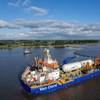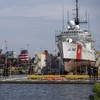New Fuels, New Rules & New Tools
Helping the Maritime Community adapt to strict emission regulations.
What has changed during 2012 in the maritime world and how has it impacted industry? It is recent IMO Marine Environment Protection Committee (MEPC), changes. IMO has adopted amendments to the International Convention for the Prevention of Pollution from Ships (MARPOL). These changes will have a vast and fundamental impact on the maritime industry and the world over the next few years. With new IMO regulations pertaining to emission control areas, fuels, sewage, and garbage rampant and coming into effect throughout the world how will and do shipping companies survive and prosper?
Fundamentally for successful companies it will be a thorough and comprehensive strategic plan that will allow implementation of these new rules and regulations. Much will have to go into these plans so that maritime companies can adopt a systematic time based methodology that will allow them to effectively complete a seamless transition.
What are the key elements that shipping companies will need to be prepared for due to the recently adopted IMO amendments to MARPOL:
- Designated the United States Caribbean Sea as a new Emission Control Area (ECA), Annex VI.
- Designated the Baltic Sea as a Special Area with respect to pollution by sewage from ships, Annex IV.
- Adopted a revised Annex V related to the control of garbage.
- Adopted mandatory measures to reduce emissions of greenhouse gases (GHGs) from international shipping.
- Designated the Strait of Bonifacio as a Particularly Sensitive Sea Area (PSSA) and adopted the first-ever international recommendations to address bio-fouling of ships, to minimize the transfer of aquatic species.
- Approved a number of ballast water management and ship recycling conventions.
On July 15, 2011, the IMO officially designated waters around Puerto Rico and the U.S. Virgin Islands as an area in which stringent international emission standards will apply to ships. For this area, the effective date of the first-phase fuel sulfur standard is 2014, and the second phase begins in 2015. Stringent nitrogen oxide (NOx) engine standards begin in 2016.
While ships are operating in the US Caribbean Sea ECA, the sulfur content of fuel oil used on board ships shall not exceed 1% micrograms/milliliter (m/m) (weight) on and after 1 January 2014, and 0.10% m/m on and after 1 January 2015. For ships, built on or before 1 August 2011 that are powered by propulsion boilers that were not originally designed for continued operation on marine distillate fuel or natural gas, the above sulfur requirements may not be applied prior to 1 January 2020.
Ships constructed on or after 1 January 2016 shall comply with the NOx emission limits when operating within the US Caribbean Sea ECA.
IMO has additionally designated waters off both North American coasts as areas that will have stringent emissions standards for vessels. In these areas the effective date for sulfur fuel or sulfur oxide-(SOx) and Particulate Matter (PM) emissions has gone into force on August 1, 2011 and has been effective as of August 1, 2012. A second phase begins in 2015.
Annex VI regulations include caps on sulfur content of fuel oil as a measure to control SOx emissions and, indirectly, PM emissions (there are no specific PM emission limits). However in the future could we see the Environmental Protection Agency (EPA) or IMO regulating PM within the US ECA?
Alternative options are also permitted in the SOx ECAs and globally to reduce sulfur emissions, such as through the use of exhaust scrubbers. For example, in lieu of using the 1.5% sulfur fuel in SOx ECAs, ships can fit an Exhaust Gas Cleaning System (ECGS) or use any other technological method to limit SOx emissions.
Another major switch would be finding an alternative fuel source such as LNG/Natural Gas or bio-fuels. Some recent developments in these areas include:
A Louisiana-based marine transportation company, specializing in towing drilling rigs and providing offshore supply and support vessels for deep water operations in the U.S. Gulf of Mexico, signed a contract in late 2011 to build 3 LNG powered clean running vessels characterized by state-of-the-art technology and outfitted beyond normal regulatory requirements. This appears to further strengthen the case and trend for new builds to use clean fuels.
The U.S. Coast Guard Cutter Henry Blake refueled recently, using a 50/50 blend of petroleum and hydro-processed renewable diesel derived from algal oil, becoming the first Coast Guard cutter to use renewable diesel as part of an operational evaluation. Successful evaluation of this fuel mixture can potentially help further the development of alternative fuels in America, while reducing or eliminating the United States dependence on foreign oil.
IMO has given some reprieve on the nitrogen oxide or NOx after treatment emission requirements by not putting them into force until January 1, 2016. This was specifically done as NOx Tier III requirements per Annex VI would go into effect at that time. All vessels construction on or after January 1, 2016 is to have diesel engines (2-Stroke and 4-Stroke) installed that meet Tier III requirements.
NOx emission limits are set for diesel engines depending on the engine maximum operating speed in RPM’s. Tier I and Tier II limits are global, while the Tier III standards apply only in NOx Emission Control Areas (ECA’s). Tier III standards will require dedicated NOx emission control technologies such as different forms of water induction into the combustion process (with fuel, scavenging air, or in-cylinder), exhaust gas recirculation, and selective catalytic reduction.
Under the new global standards, NOx emissions will be reduced, and the fuel sulfur cap will drop to 5,000 ppm in 2020. Under the new geographic standards, ships operating in designated ECA’s will be required to use engines that meet the most advanced technology. These standards for NOx emissions begin in 2016, and will require fuel with a sulfur content not exceeding 10,000 ppm in the first phase of the program, and 1,000 ppm in the second phase of the program.
An additional area of major concern is Black Carbon. Studies are underway to address the impact of black carbon emissions from vessels in the Arctic, as well as how to measure black carbon emissions from vessels and how to implement appropriate measures to reduce the black carbon emissions footprint in the Arctic.
A common definition of Black Carbon is that it is a strongly light-absorbing carbon material produced by incomplete combustion of fuel oil and emitted as a solid primary particulate matter. It differs from sulfur dioxide (SOx) emissions as it is classified as a secondary particulate matter pollutant. Black carbon has significant effects on climate change and when deposited on snow and ice in the Arctic and lower latitudes, it darkens light surfaces and absorbs energy, causing snow and ice to melt.
mendments to MARPOL Annex IV Prevention of Pollution by Sewage from ships were adopted including the potential of establishing special areas or zones for the prevention of pollution from passenger ships including the Baltic Sea.
IMO adopted the revised MARPOL Annex V Regulations for the prevention of pollution by garbage from ships. The amendments will go into force on 1 January 2013.
Comprehensive changes include the following: a new requirement specifying that discharge of all garbage into the sea is prohibited, except as specifically provided otherwise (what is permitted under certain conditions includes food wastes, cargo residues, water used for washing deck and external surfaces containing cleaning agents or additives that are not harmful to the marine environment), and additions to the requirements for placards and garbage management plans to fixed and floating platforms engaged in exploration and exploitation of the sea-bed.
The Strait of Bonifacio is the strait between Corsica and Sardinia named after the Corsican town Bonifacio. It divides the Tyrrhenian Sea and the western Mediterranean Sea. The strait is notorious among sailors for its strong currents, shoals and weather patterns as well as other obstacles.
Since a tanker disaster in 1993, the passage through the Strait of Bonifacio has been prohibited for only French and Italian flag tank ships.
MEPC designated the Strait of Bonifacio as a Particularly Sensitive Sea Area (PSSA). What this entails is that mariners are requested to exercise extreme care if they are to navigate in the PSSA bounded area as the region has a unique ecosystem that has been prone to accidents. Many prudent mariners that ply the Mediterranean Sea believe this was long overdue.
Initial international recommendations to address bio-fouling of ships, to minimize the transfer of aquatic species were proposed by MEPC. Instructions for the control and management of ships' bio-fouling to minimize the transfer of non-native or non-indigenous species will address the risks of introduction of dangerous aquatic species.
Bio-fouling is a significant mechanism for species transfer by vessels. A single organism has the potential to regenerate many thousands of times. Reducing or eliminating bio-fouling will significantly reduce the risk of transfer of non-native or non-indigenous species.
MEPC approved a number of ballast water management systems and adopted guidelines related to the implementation of both the ballast water management and ship recycling conventions. These new methods will provide the ability to reduce or prevent risks arising from the transfer of dangerous environmentally unfriendly non-native or non-indigenous species.
Approval was granted to two and basic approval to seven ballast water management systems that make use of active substances.
What are all these changes leading to? It is readily apparent that one must have the ability to constantly change and adapt and it is of paramount importance today in the maritime industry. Ship’s do need to become maritime lean (similar to lean manufacturing) while removing all fat or excess and staying sustainable, green and environmentally friendly. The alternatives are that outdated and non-compliant vessels will incur penalties and fines and end up in the scrap yard. This is only the precursor for a reduction in the number of shipping companies. Mariners additionally need to be well trained and fully cognizant of the changing seascape of rules and regulations. They must be prudent and knowledgeable mariners that are able to use their expertise and skills to successfully manage their vessels in this globally regulated market.
CDR Emil A. Muccin, USMS is an Assistant Professor in Nautical Science/Marine Transportation at the United States Merchant Marine Academy. The views expressed in this article are the author’s own and not those of the U.S. Merchant Marine Academy, the Maritime Administration, the Department of Transportation or the United States government.
(As published in the November 2012 edition of Maritime Reporter - www.marinelink.com)














